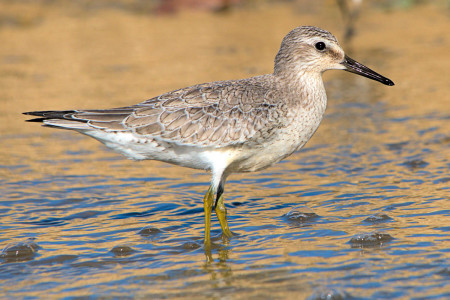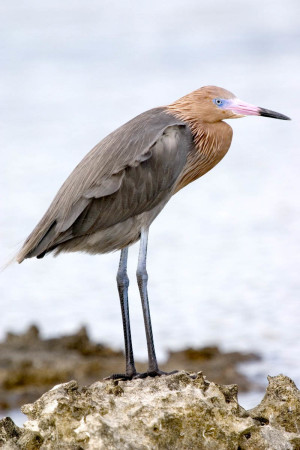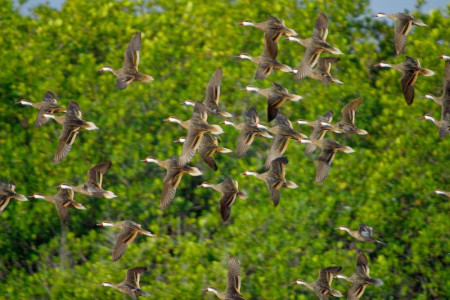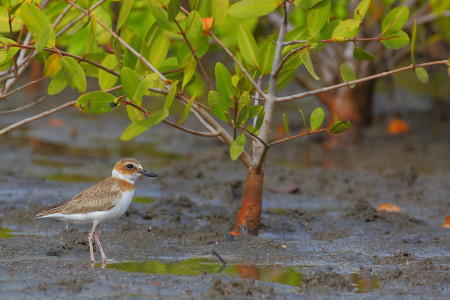
One bird, two bird, three bird, four! Since 2010, hundreds of dedicated volunteers have been spreading out across the Caribbean’s vast wetlands, large and small, and counting birds for the Caribbean Waterbird Census (CWC). The goal is to learn more about the status of migratory and resident waterbirds and strengthen their conservation.
Waterbirds in the Caribbean, and the wetlands they depend on, are challenging to monitor. The Caribbean region is spread across 7,000 islands, islets, and cays and many wetlands are difficult to access. But our intrepid counters have braved gooey mud, marauding mosquitos, and sweltering heat to help us gather data of great importance to conservation.
Waterbirds are species that depend on aquatic habitats, like mangroves, salt ponds, tidal flats, lagoons, beaches, and freshwater marshes, to complete portions of their life cycle. Unfortunately, many species are in severe decline, particularly shorebirds. Semipalmated Sandpiper that once numbered over two million on Caribbean and South American wintering grounds have dropped by 80%. Another long-distance migrant shorebird, the Red Knot, is now listed as Threatened under the Endangered Species Act, having declined by 80% as well. The Zapata Rail, endemic to sawgrass habitat in the Zapata Swamp in southern Cuba, has not been seen with certainty in nearly 20 years.
Wetlands are important for birds and for our well being too. Not only do they provide a home for wildlife, they also provide people with clean water, protection from floods and erosion, and opportunities for recreation and wildlife viewing.

For years wetlands have been destroyed for development, damaged by pollution, or threatened by tourism, agriculture, cattle, industry, or sea level rise. Because wetlands are vital to birds and people, it’s important to know where they are, what birds are living in them, and what times of year they are being used.
BirdsCaribbean is answering these questions through the CWC, a program that aims to increase support for waterbird and wetland conservation by training a cadre of people to observe and record birds in wetlands across the Caribbean. Natural resource agency staff and citizen scientist volunteers help answer important questions while gaining an understanding and appreciation of migratory birds and the wetlands that they live in.
Since the beginning of the program in 2010, over 200 people from 21 countries have surveyed more than 700 areas! Each year, more and more people take part in the CWC. We have learned a lot of cool stuff over the last six years!
For example, several places stand out for their high numbers of birds. Sur de Los Palacios, Cuba is important to Wilson’s Plover throughout the fall, winter, and spring. This medium-sized bird is on the 2014 State of the Birds Watchlist, which lists species most in danger of extinction without significant conservation action. Knowing where they spend much of their time can lead to increased conservation for these sites in Cuba. Monte Cristi in northwestern Dominican Republic has been discovered as an incredibly important site for many shorebird species throughout the migration and winter season. Counts in the fall are especially high for Greater Yellowlegs (870 individuals), Lesser Yellowlegs (3,250 individuals) and Semipalmated Sandpiper (3,150 individuals), all being the highest overall counts for the species throughout the Caribbean!

Shorebirds like these only weigh a couple ounces; the Semipalmated Sandpiper weighs in at just a smidge more than a quarter, and flies thousands of miles from it’s breeding grounds in the Arctic to it’s wintering grounds in South America. Knowing where this bird stops along the way is important so conservationists can protect the places it needs to rest and feed for their long journey.
Another indicator of importance is the diversity—or how many different kinds of birds—are observed. Two locations in Guadeloupe (Pointe des Chateaux and Petite-Terre) and one in Cuba (Sur de Los Palacios) had over ten different shorebirds counted and seven other sites, located in Guadeloupe, Grenada, DR, Bahamas, Cuba, and Grenada recorded 9, 8 or 7 shorebird species. Some sites in the Caribbean like Sur de Los Palacios in Cuba and Monte Cristi in the Dominican Republic stand out for high numbers of all waterbirds, not just shorebirds. Of the 241 sites monitored in 2014 a total of 293 species were recorded!
What do all these numbers really mean? Knowing which birds are using what areas helps conservationists identify the most important sites to protect. Raising awareness, and showing the value of wetlands to local communities can lead to better care and protection of the wildlife using them. They become places to promote environmental education and bird and nature tourism. Enhancing key sites by installing boardwalks, viewing towers, and signs makes them attractive to visitors, which in turn increases their value for local people, livelihoods, and the economy.

While participation in the CWC has increased every year and we have already learned a great deal from the counts, there is still much work to be done! With over 7,000 islands and islets in the Caribbean, many important sites have not yet been surveyed. In addition, it’s important to continue surveying the same sites over the long term in order to document changes in waterbird numbers in relation to changing environmental conditions, for example, under climate change. Finally, we must continue to raise awareness about the importance and value of these sites to birds and people and promote protection and good management. Doing so will ensure that these critical wetlands are not lost forever; and birds and people will have a place to thrive.
To find out how to participate in the CWC, click here.
A report on the first 5 years of the CWC can be downloaded here (PDF).
